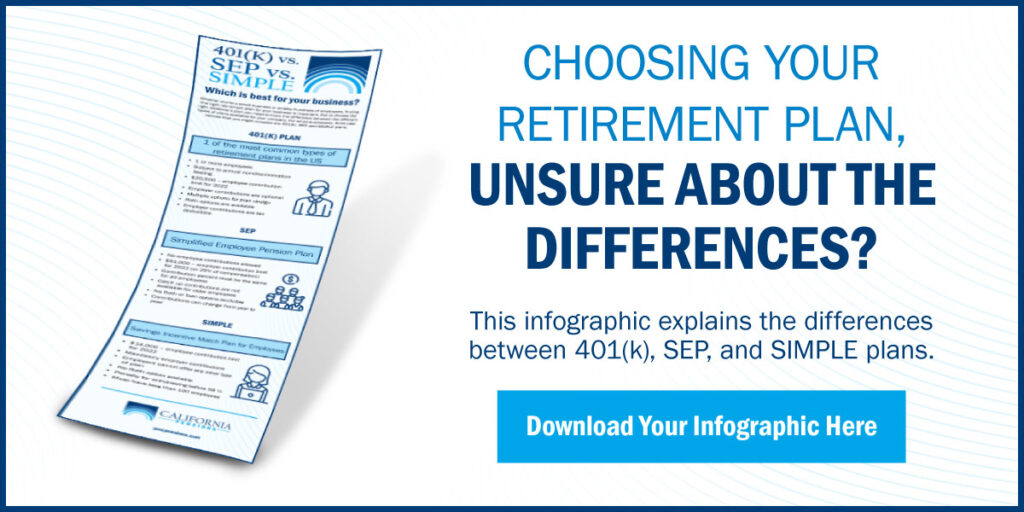For workers looking to start their own business or work independently, retirement plans are available that allow these entrepreneurs to build their savings on their own. One such plan includes Solo 401(k)’s: a specific kind of retirement plan for business owners with no employees. While like a traditional 401(k) plan and rather direct in its design, Solo 401(k) users have rules which must be adhered to in order to be used correctly and save in a tax-advantaged way. So, what Solo 401(k) rules can owners expect to follow? Let’s review all the Solo 401(k) rules business owners should consider before creating an account.
Learn how to Save More for Retirement – Check out our Infographic
Rules to Follow for Solo 401(k)s
Eligibility
Solo 401(k) rules often do not have age or service restrictions on their plans. As a result, any individual can set up a Solo 401(k) as soon as they start their business so long as they have no employees. However, many business owners choose to wait to set up their Solo 401(k)’s with eligibility requirements just in case they should ever hire an employee. Spouses who work in or for the business can also participate in a Solo 401(k) and still be considered a Solo 401(k). This allows both owner and spouse to contribute income to the 401(k), building the joint retirement savings to the maximum amount in less time.
Contribution Limits
According to the 2023 Solo 401(k) limits, business owners can contribute to their retirement accounts as both employer and employee. Under these rules, owners can contribute up to the maximum amount to their Solo 401(k) limits, which are capped as follows:
- Employee contribution: $22,500 or 100% of your income depending on which is less. Individuals 50 and over may contribution additional funds up to $6,500.
- Employer contribution: $61,000, with additional profit-sharing contributions allowed up to 25% of your annual income. Annual income contributions are also restricted, capping at $305,000 for members.
- For both employer and employee contribution: $61,000, or $67,500 for members 50 and older.
Business owners should remember that these limits apply to other accounts as well. If a business owner has additional employment that provides a retirement savings account, some limits must be appropriately coordinated with those other plans. Generally, salary deferrals are one limit across all sources of employment; employer contributions are not.
Taxes
Business owners have the great advantage of choosing whether to make their Solo 401(k) a tax-deferred or Roth account. However, like any account, certain Solo 401(k) rules apply and must be carefully considered before implementing your retirement strategy. While traditional tax-deferred Solo 401(k)’s allow business owners to contribute funds to their account outside of taxes and save in the present, deferring taxes requires they be paid in future withdrawals and distributions during retirement. As opposed to the traditional tax-deferral, Roth Solo 401(k)’s don’t provide for an initial tax-deferral on employee contributions and require taxes to be applied before depositing into the account. This feature allows Solo 401(k) funds to grow and be distributed tax-free later. When considering between a tax-deferred or Roth Solo 401(k), business owners should carefully examine their finances to decide the right plan for their retirement goals. Please note that all employer contributions are considered pre-tax.

Withdrawals
Like most retirement plan accounts, Solo 401(k) have rules about when members can withdraw their savings. Typically, business owners have limited opportunities to withdraw money from their Solo 401(k) prior to the age of 59 ½. Should an individual need to withdraw before that age, different penalties apply depending on the account type:
- Tax-deferred Solo 401(k): members making early withdrawals must not only pay taxes on their retirement contributions, but also pay an additional 10% early withdrawal penalty. Pre-tax accounts derived from employee contributions may only be withdrawn for hardship, while employer accounts can have more liberal requirements.
- Roth Solo 401(k): Salary deferrals are never allowed to leave before 59 ½ years of age unless due to hardship. Taxes only apply to earnings that don’t meet Roth holding requirements.
Opening a Solo 401(k)
While Solo 401(k)s make a great vehicle to save for retirement, it’s important that business owners understand the rules required to opening such plans. Here are the basic requirements needed to create a Solo 401(k):
- Business owners establishing a Solo 401(k) in the United States must first provide their business Employer Identification Number (EIN). Individuals that typically use their Social Security number should obtain an EIN if only for plan establishment purposes. Various documents and filings will not be accepted with a Social Security Number by the Federal government.
- Annual Deadlines: Upon establishing where to set up your Solo 401(k) account, it’s crucial that members keep track of deadlines, as missing them could mean late penalties and missing out on retirement contributions for the tax year. Under the SECURE Act, Solo 401(k) users can open and establish their accounts by December 31st, 2022, or until sponsors file taxes for the previous year if they are only doing employer contributions.
Precautions to Take with a Solo 401(k)
In addition to the guidelines and retirement benefits offered through these plans, business owners should also be aware of some common mistakes with Solo 401(k)’s. Before finalizing a retirement strategy for your business, take a moment to consider or discuss these requirements with your administrator, tax professional and financial advisor:
- If plan assets go over $250,000 in one or a series of qualified plans sponsored by the same business, a Form 5500 must be filed. All terminating plans must also file Form 5500 for the last year of operation.
- Should Solo 401(k) owners hire an employee, it is critical to make sure the plan rules are reviewed PRIOR to hiring any employee. Options include amending the plan to handle employees participating or by terminating the plan entirely. If a Solo 401(k) plan exists, owners could face serious compliance consequences for not giving eligible employees contribution options even if no one contributes. Failing to offer an existing plan to eligible employees will result in the employer owing 100% vested contributions to employees.
- Solo 401(k) users who own multiple businesses or hold significant stakes in other businesses need to make sure any plan covers the right people. Owners can’t use a Solo 401(k) if he or she own one company with employees and another without any. It is highly recommended to consult with ERISA counsel or TPA to help guide your retirement plan through these requirements.
- With help from your administrator, review all Solo 401(k) rules and forms to ensure plan documents stay up to date within the law.
Though there are many Solo 401(k) rules to follow, business owners can rest assured whichever account option they choose to make will help build long-term retirement benefits. California Pensions supports Solo 401(k) clients in reaching the best savings and financial stability for their retirement plans by making the process as simple as possible and by helping ensure compliance with the rules. Contact California Pensions today to learn more.





